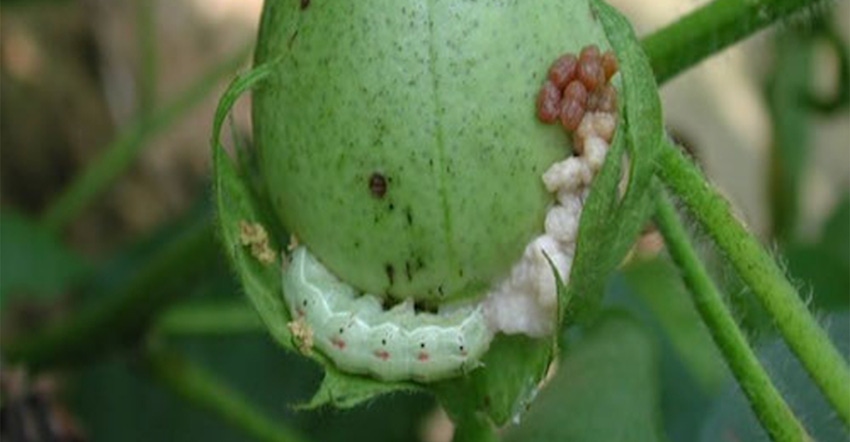
Taylor Harris, a new graduate student at the University of Arkansas, spoke on moth trapping trends in Arkansas as well as the difference in various moth traps, during the University of Arkansas System's online ACPA Conference. Her research also further looked at pyrethroid resistance in corn earworm.
"As a part of my work in the Extension entomology program, I've maintained and evaluated all of the moth traps to determine moth trends throughout the year," Harris said. "We use these numbers to help consultants and farmers know when to scout and when to spray to help control corn earworm."
Trapping moths
Corn earworms have a huge economic impact. In corn, it cost 3-4% yield loss. In cotton, it causes a 3.8% yield loss. While in soybeans, it causes about a 4% yield loss.
"For our research and educational program, we must have accurate numbers, so we use modified Hartstack traps," Harris said. "We have 10 traps in Lonoke County, six in Drew County, and then we have five tobacco budworm traps in each of those counties to collect data as well."
The team first starts setting these traps out in late April and continues to monitor them through late September.
"We initiate these traps in late April because that's when the moths generally start moving in, and we get a lot of our moths from weather out of Texas," she said. "A few years ago, Ben Thrash looked at weather patterns in June for Arkansas, and out of 30 days in June, 27 of them had wind coming from the southwest from Texas. The moths follow these wind patterns."
When setting out moth traps, it is important to put them in an open space for good airflow and not by a building or in the middle of a field where they will be in the grower's way.
"Make sure it's a big open space where plants aren't growing around it," Harris said. "Also, make sure that it's out of the way, so it won't be a driving hazard when working in a field. Generally, we will put them close to a telephone pole, so it is out of the farmer's way.
"The moths are attracted to the traps baited with female pheromone. Once they fly up in the trap, they cannot come back down because it is a cone shape, and they can only fly up. They fly into the top part of the trap, and that's the part we take to count and collect the moths for the rest of our research."
Keeping the area around the trap clean is imperative because, if grass or weeds grow up around the bottom of the trap, the moths can crawl out.
"We use Roundup to keep the area under and around the trap clean of weeds and grass, or a weed eater works just as well," she said. "We use the moth traps to not just trap moths but to examine trends in moth migration. There is always a big peak around the Fourth of July."
Different moth traps
To determine if the modified Hartstack is still the best trap, a few other available moth traps that were tested include the bucket trap, basket trap, and light trap.
"In 2017 and 2020, we tested a few types of traps to try to find if there was something easier to transport as well as something cheaper and still effective," Harris said.
The Hartstack trap used costs about $250 per trap, and transportation is difficult due to its size and shape.
"I can fit probably about five traps in my truck, maybe six," she said. "They're big and bulky, so we must make several trips when we go to set out traps, which takes a lot of time. They are durable and excellent quality, though. However, they are hard to find because, generally, you have to have someone make them for you or make them yourself."
The bucket trap was tested in 2017. It is a lot smaller and costs about $10 a trap.
"Transportation is easy with this trap being so small, and it has consistent quality," Harris said. "Even if it does break, it is a lot easier to buy a new one than to get it fixed.
"The basket traps are also small and easy to transport since the mesh part at the bottom collapses to a flat surface. They are decent quality, and they're cheaper and easy to handle since all you have to do is hang them up, and you are good to go."
The team is continuing to test the light traps through a company that is working to perfect the trap.
"From what we found, the Hartstack traps are still, by far, the most efficient for our research and educational program," she said.
"Another part of this research is using the moths from these traps to test resistance to pyrethroids and other insecticides. We get vials that are treated with insecticides from the Mississippi State lab, and we bring back moths caught in the trap back to the lab. We place all the healthy moths in the vials."
They put 40 in untreated vials and 60 in treated vials. After 24 hours, they check the vials for mortality.
"We found out that the corn earworm has developed resistance to many insecticide classes," Harris said. "Now, we know it is resistant to pyrethroids, so we have made that transition to diamides, but they are starting to show tolerance on diamides, specifically chlorantraniliprole. The research is a work in progress, so that is something we will continue to do."
Read more about:
Corn EarwormAbout the Author(s)
You May Also Like




